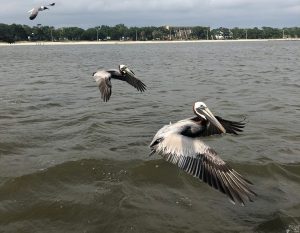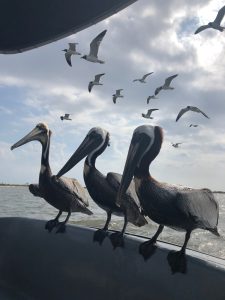
My husband was born and raised in Pensacola, spending many of his childhood weekends fishing, swimming, or camping along local waterways. So, it was a bit of a surprise when he told me he didn’t see his first pelican until he was 12 or 13 years old. He was riding over the Pensacola Bay bridge, when a large bird flew into their line of sight and his dad exclaimed, with genuine excitement, “The pelicans are back!!” This was in the mid-1980’s, and Eric was stunned to see this large-bodied, graceful bird coasting alongside them for the first time. His dad explained the birds were numerous in the bay when he was a child in the 1950’s, but they slowly disappeared from the area until none were seen. The same thing happened concurrently in Louisiana—by the early 1960’s, the “Pelican State” had none. So, where did they go for those 30-40 years?

As you can probably guess, pelican populations post-WWII suffered the same fate as many other large birds. Populations of eagles, ospreys, pelicans, and raptors were decimated by the increasingly common use of Dichloro-diphenyl-trichloroethane (DDT) as a mosquito repellent, along with endrin, an agricultural and horticultural pesticide. What seemed like the wonder cure for fighting off mosquito-borne disease and farmers who’d spent their lives battling pests had unwittingly yielded devastating consequences for native wildlife. DDT didn’t outright kill birds, but its presence in their diet of fish led to a chemical breakdown of the structure of their eggs. The shells were so thin that they could not survive normal wear and tear of the hatching process, so new young were not produced. Without the next generation, local pelicans died off as adults without leaving offspring. This, too, was a time of massive fish kills in local bayous, due to excess pollutants.

Brown pelicans (Pelecanus occidentalis) are great fun to watch, especially when they’re fishing. They have incredible eyesight, and once they spot fish below the surface, they enter a dive-bomb—sometimes from 50 feet up—of warlike proportions. After they crash into the water, they lift their water-and-fish-filled bills, drain out the water, and guzzle the fish down, whole. Pelicans are colony-dwelling birds—where you see one sitting on a post, you’re likely to see dozens. Despite their large, sometimes unwieldy bodies, they are incredibly graceful flyers, gliding together on 6-8′ wingspans.

During the worst of the impacts from DDT, healthy populations still existed in south Florida. It was from relocation of some of these birds (after the pesticides were banned) that the northern Gulf Coast population regained its stability. Now, pelicans are less threatened by chemicals but do suffer losses from plastic pollution and loss of habitat.
The story of the brown pelican’s return, to me, is less a sad story than one of redemption. These incredible birds did not go extinct. Humans realized the error of our ways (thanks in large part to the courageous Rachel Carson), took serious corrective actions, and wildlife came back. The pelicans returned in the 1980’s, while ospreys and eagles have only made a solid comeback in the last 20 years. Our bayous and bays are much cleaner and full of life than they were in the 1960’s and 70’s. As a result, seagrasses are gaining ground and local bird populations are on the Audubon map. It is unfortunate that we seem to learn our lessons the hard way, but it does give me hope that we can still learn from our mistakes and make improvements before irreversible damage is done.
 16
16
